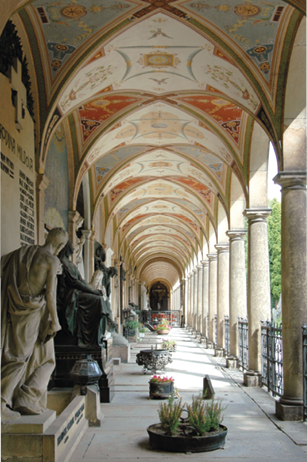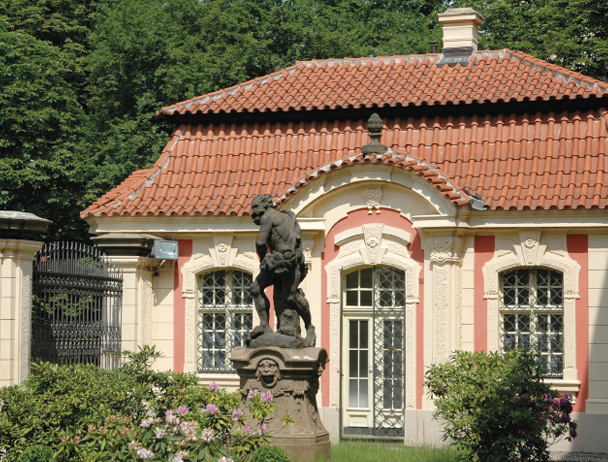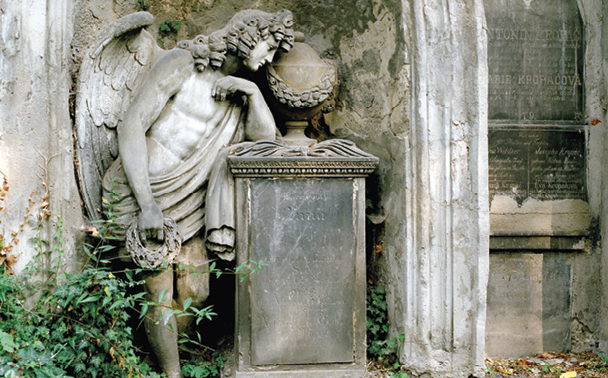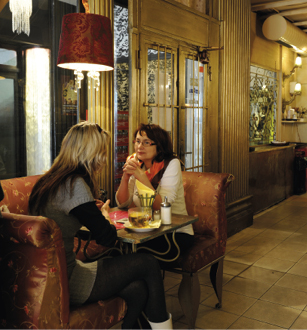Vyšehrad, Vinohrady and Žižkov
Cafés
Restaurants
Pubs and bars
Clubs and venues
South of the city centre, the fortress of Vyšehrad makes for a perfect afternoon escape away from the human congestion of the Old and New towns: its illustrious cemetery shelters the remains of Bohemia’s artistic elite; the ramparts afford superb views over the river; and below the fortress there are several interesting examples of Czech Cubist architecture to seek out. The gentrified suburb of Vinohrady, to the east, is a late nineteenth-century residential neighbourhood, dominated by long streets of grandiose apartment blocks, with one or two specific sights to guide your wandering. By contrast, Žižkov, further north, is a grittier working-class district, whose shabby streets contain many pubs and clubs. The highlight here is the National Monument, a must for fans of Eastern European history.
Cubist villas
map
Even if you harbour only a passing interest in modern architecture, it’s worth seeking out the cluster of Cubist villas below the fortress in Vyšehrad. The most impressive example is the apartment block at Neklanova 30, begun in 1913, which brilliantly exploits its angular location. Further along Neklanova, at no. 2, there’s another Cubist facade, and around the corner is the most ambitious of the lot, the Kovařovicova vila (Libušina 49), which uses prism shapes and angular lines to produce the sharp geometric contrasts of light and dark shadows characteristic of Cubist painting.
Kovařovicova vila
Vyšehrad
map
V pevnosti 5b  praha-vysehrad.cz. Open 24hr. Free.
praha-vysehrad.cz. Open 24hr. Free.
The rocky red-brick fortress of Vyšehrad – literally “High Castle” – has more myths attached to it than any other place in Bohemia. According to Czech legend, this is the place where the Slav tribes first settled in Prague and where the “wise and tireless chieftain” Krok built a castle, whence his youngest daughter Libuše went on to found Praha itself. Alas, the archeological evidence doesn’t really bear this claim out. What you see now are the remains of a fortified barracks built by the Habsburgs and then turned into a public park.
You can explore the fortress’s northern entrance, or Cihelná brána (daily: April–Oct 9.30am–6pm; Nov–March 9.30am–5pm; free), and the adjacent dungeons, or kasematy (same hours; 60Kč). After a short guided tour of a section of the underground passageways underneath the ramparts, you enter a vast storage hall, which shelters several of the original statues from Charles Bridge, and, when the lights are switched off, reveals a camera obscura image of a tree.
Over in the southwestern corner of the fortress, in the Gothic cellar (same hours; 50Kč), there’s also a permanent exhibition on the history of Vyšehrad. The rock’s big moment in Czech history was in the eleventh century when Přemysl Vratislav II – the first Bohemian ruler to bear the title “king” – built a royal palace here to get away from his younger brother who was lording it in the Hrad. Within half a century the royals had moved back to Hradčany, into a new palace, and from then on Vyšehrad began to lose its political significance.
Cihelná brána, Vyšehrad
Getting to Vyšehrad
To reach Vyšehrad, take tram #2, #3, #7, #14, #17, #18, #21 or #24 to Výtoň, and either wind your way up Vratislavova to the Cihelná brána or take the steep stairway from Rašínovo nábřeží that leads up through the trees. Alternatively, from Vyšehrad metro station, walk west past the ugly Prague Congress Centre, and enter via V pevnosti, where there’s an information centre (daily: April–Oct 9.30am–6pm; Nov–March 9.30am–5pm).
Church of sv Petr and Pavel
map
K rotundě 10. Daily 10.30am–5.30pm. 50Kč.
The twin openwork spires of this blackened sandstone church, rebuilt in the 1880s in neo-Gothic style on the site of an eleventh-century basilica, are now the fortress’s most familiar landmark. Inside, you can admire the church’s Art Nouveau murals, which cover just about every available surface.
Doors of the Church of sv Petr and Pavel
Vyšehrad Cemetery (Vyšehradský hřbitov)
map
 slavin.cz. Daily: March, April & Oct 8am–6pm; May–Sept 8am–7pm; Nov–Feb 8am–5pm. Free.
slavin.cz. Daily: March, April & Oct 8am–6pm; May–Sept 8am–7pm; Nov–Feb 8am–5pm. Free.
Most Czechs come to Vyšehrad to pay a visit to the cemetery. It’s a measure of the part that artists and intellectuals played in the foundation of the nation, and the regard in which they are still held, that the most prestigious graveyard in the city is given over to them: no soldiers, no politicians – not even the Communists managed to muscle their way in here (except on artistic merit). Sheltered from the wind by its high walls, lined on two sides by delicate arcades, it’s a tiny cemetery filled with well-kept graves, many of them designed by the country’s leading sculptors.
To the uninitiated only a handful of figures are well known, but for the Czechs the place is alive with great names (there’s a useful plan of the most notable graves at the entrance nearest the church). Ladislav Šaloun’s grave for Dvořák, situated under the arches, is one of the more showy ones, with a mosaic inscription, studded with gold stones, glistening behind wrought-iron railings. Smetana, who died twenty years earlier, is buried in comparatively modest surroundings near the Slavín monument, the cemetery’s focal point, which is the communal resting place of more than fifty Czech artists, including the painter Alfons Mucha and the opera singer Ema Destinová. The grave of the Romantic poet Karel Hynek Mácha was the assembly point for the demonstration on November 17, 1989, which triggered the Velvet Revolution. This was organized to commemorate the fiftieth anniversary of the Nazi closure of Czech higher education institutions. A 50,000-strong crowd gathered here and attempted to march to Wenceslas Square, getting as far as Národní before being beaten back.
Vyšehrad Cemetery
Police Museum
map
Ke Karlovu 1,  Karlovo náměstí. Tues–Sun 10am–5pm. 50Kč.
Karlovo náměstí. Tues–Sun 10am–5pm. 50Kč.
The former Augustinian monastery of Karlov houses the Police Museum, which concentrates on road and traffic offences, and the force’s latest challenges: forgery, drugs and murder. There’s a whole section on the old Iron Curtain and espionage, but not a huge amount of information in English. If you’ve got kids, however, they might enjoy driving round the mini-road layout on one of the museum trikes.
Na Karlově church
map
Ke Karlovu,  Karlovo náměstí. Opening hours vary. Free.
Karlovo náměstí. Opening hours vary. Free.
Founded by Emperor Charles IV and designed in imitation of Charlemagne’s tomb in Aachen, this octagonal church is quite unlike any other in Prague. If it’s open, you should take a look at the dark interior, which was remodelled in the sixteenth century by Bonifaz Wohlmut. The stellar vault has no central supporting pillars – a remarkable feat of engineering for its time, and one which gave rise to numerous legends about the architect being in league with the Devil.
Vila Amerika (Dvořák Museum)
map
Ke Karlovu 20,  I. P. Pavlova. Tues–Sun 10am–1.30pm & 2–5pm. 50Kč.
I. P. Pavlova. Tues–Sun 10am–1.30pm & 2–5pm. 50Kč.
The russet-coloured Vila Amerika was originally named after the local pub, but is now a museum devoted to Antonín Dvořák (1841–1904), the most famous of all Czech composers, who lived for a time on nearby Zitná. Even if you’ve no interest in Dvořák, the villa itself is a delight, built as a Baroque summer house from around 1720. The tasteful period rooms, with the composer’s music wafting in and out, and the tiny garden dotted with Baroque sculptures, together go a long way towards compensating for what the display cabinets may lack.
Vila Amerika
Náměstí Míru
map
If Vinohrady has a centre, it’s the leafy square of Náměstí Míru, a good introduction to this neighbourhood. The most flamboyant building here is the Vinohrady Theatre (Divadlo na Vinohradech), built in 1907, with both Art Nouveau and neo-Baroque elements. Completely dominating the centre of the square is the brick basilica of sv Ludmila, designed in the late 1880s in a severe neo-Gothic style by the great neo-Gothicizer Josef Mocker, though the interior has the odd flourish of Art Nouveau. In front a statue commemorates the Čapek brothers, writer Karel and painter Josef, local residents who together symbolized the golden era of the interwar republic. Karel died of pneumonia in 1938, while Josef perished in Belsen seven years later.
Kostel Nejsvětějšího Srdce Páně
map
Náměstí Jiřího z Poděbrad,  Jiřího z Poděbrad. Opening hours vary. Free.
Jiřího z Poděbrad. Opening hours vary. Free.
Prague’s most celebrated modern church, Nejsvětějšího Srdce Páně (Church of the Most Holy Heart of Our Lord) was built in 1928 by the Slovene architect Josip Plečnik. It’s a marvellously eclectic work, employing a sophisticated potpourri of architectural styles: a Neoclassical pediment and a great slab of a clock tower with a giant transparent face in imitation of a Gothic rose window, as well as the bricks and mortar of contemporary constructivism. Plečnik also had a sharp eye for detail – look out for the little gold crosses inset into the brickwork like stars, inside and out, and the celestial orbs of light suspended above the congregation.
Žižkov TV Tower (Televizní věž)
map
Mahlerovy sady 1,  Jiřího z Poděbrad.
Jiřího z Poděbrad.  www.towerpark.cz. Daily 9am–midnight. 230Kč.
www.towerpark.cz. Daily 9am–midnight. 230Kč.
At 216m in height, the Žižkov TV Tower is Prague’s tallest building. Close up, it’s an intimidating futuristic piece of architecture, made all the more disturbing by the giant babies crawling up the sides, courtesy of artist David Černý. Begun in the 1970s in a desperate bid to jam West German television transmissions, the tower became fully operational only in the 1990s. In the course of its construction, however, the Communists saw fit to demolish part of a nearby Jewish cemetery that had served the community between 1787 and 1891; a small section survives to the northwest of the tower. Following a major reconstruction, the tower now features a café, restaurant, bar, observatory and even a one-room hotel.
Žižkov TV Tower
Olšany cemeteries (Olšanské hřbitovy)
map
Vinohradská,  Flora. Daily dawn–dusk. Free.
Flora. Daily dawn–dusk. Free.
The vast Olšany cemeteries were originally created for the victims of the great plague epidemic of 1680. The perimeter walls are lined with glass cabinets, stacked like shoeboxes, containing funeral urns and mementoes, while the graves themselves are a mixed bag of artistic achievements, reflecting the funereal fashions of the day as much as the character of the deceased. The cemeteries are divided into districts and criss-crossed with cobbled streets; at each gate there’s a map and an aged janitor ready to point you in the right direction.
The cemeteries’ two most famous incumbents are an ill-fitting couple: Klement Gottwald, the country’s first Communist president, whose remains were removed from the mausoleum on Žižkov Hill after 1989 and reinterred here; and Jan Palach, the philosophy student who set light to himself in January 1969 in protest at the Soviet occupation. More than 750,000 people attended Palach’s funeral, and in an attempt to put a stop to the annual vigils at his graveside, the secret police removed his body and reburied him in his home town outside Prague. In 1990, Palach’s body was returned to Olšany; you’ll find it just to the east of the main entrance.
Gravestone at Olšany
New Jewish Cemetery (Nový židovský hřbitov)
map
Izraelská 1,  Želivského. April–Oct Mon–Thurs & Sun 9am–5pm, Fri 9am–2pm; Nov–March Mon–Thurs & Sun 9am–4pm, Fri 9am–2pm. 50Kč.
Želivského. April–Oct Mon–Thurs & Sun 9am–5pm, Fri 9am–2pm; Nov–March Mon–Thurs & Sun 9am–4pm, Fri 9am–2pm. 50Kč.
Founded in the 1890s, the New Jewish Cemetery was designed to last for a century, with room for 100,000 graves. It’s a truly melancholy spot, particularly in the east of the cemetery, where large empty allotments wait in vain to be filled by the generation that perished in the Holocaust. Most people come here to visit Franz Kafka’s grave, which is located 400m east along the south wall and signposted from the entrance. He is buried, along with his mother and father (both of whom outlived him), beneath a plain headstone; the plaque below is dedicated to the memory of his three sisters, who died in the concentration camps.
Žižkov Hill
map
U památníku, bus #133, #175 or #207 from  Florenc.
Florenc.
Žižkov Hill is the thin green wedge of land that separates Žižkov from Karlín, the grid-plan industrial district to the north. From its westernmost point, which juts out almost to the edge of Nové Město, is the definitive panoramic view over the city centre. It was here, on July 14, 1420, that the Hussites enjoyed their first and finest victory at the Battle of Vítkov, under the inspired leadership of the one-eyed general, Jan Žižka (hence the name of the district). Outnumbered by ten to one, Žižka and his fanatical troops thoroughly trounced the Bohemian king (and Holy Roman Emperor Sigismund) and his papal forces.
Despite its totalitarian aesthetics, the giant concrete Žižkov monument, which graces the crest of the hill, was actually built between the wars as a memorial to the Czechoslovak Legion who fought against the Habsburgs in World War I – the gargantuan statue of the mace-wielding Žižka, which fronts the monument, is reputedly the world’s largest equestrian statue. The building was later used by the Nazis as an arsenal, and eventually became a Communist mausoleum. In 1990, the Communists were cremated and quietly reinterred in Olšany. The monument now houses a fascinating museum ( nm.cz; April–Oct Wed–Sun 10am–6pm; Nov–March Thurs–Sun 10am–6pm; 120Kč) on the country’s twentieth-century history; there’s also a Communist monument to the fallen of World War II and a café on top, with great views over Prague’s suburbs.
nm.cz; April–Oct Wed–Sun 10am–6pm; Nov–March Thurs–Sun 10am–6pm; 120Kč) on the country’s twentieth-century history; there’s also a Communist monument to the fallen of World War II and a café on top, with great views over Prague’s suburbs.
Žižkov monument
Army Museum (Armádní muzeum)
map
U památníku 2, bus #133, #175 or #207 from  Florenc
Florenc  vhu.cz. Tues–Sun 10am–6pm. Free.
vhu.cz. Tues–Sun 10am–6pm. Free.
Guarded by a handful of unmanned tanks, howitzers and armoured vehicles, the Army Museum has a permanent exhibition covering the country’s military history from 1914 to 1945. A fairly evenly balanced account of both world wars includes coverage of controversial subjects such as the exploits of the Czechoslovak Legion, the Heydrich assassination and the 1945 Prague Uprising.
Cafés
Blatouch
map
Americká 17  222 328 643. Mon–Thurs noon–midnight, Fri noon–1am, Sat 1pm–1am, Sun 1–11pm.
222 328 643. Mon–Thurs noon–midnight, Fri noon–1am, Sat 1pm–1am, Sun 1–11pm.
Unpretentious café in the heart of Vinohrady that predates the flashier establishments all around. Salads, toasted sandwiches, pastas and tortillas, many of them vegetarian, make up the menu and there’s Ferdinand beer from Benešov.
Caféterapie
map
Na hrobci 3. Mon–Fri 8.30am–10pm, Sat 9am–10pm, Sun 10am–10pm.
Small, simply furnished café that serves up healthy Mediterranean-influenced salads, sandwiches, toasties and a few hot dishes.
Kaaba
map
Mánesova 20. Mon–Fri 8am–midnight, Sat 9am–midnight, Sun 10am–midnight.
This stylish ice-cream parlour/café attracts a young, cool crowd with its mismatched retro decor. Serves breakfast, light meals and sundaes.
Radost FX Café
map
Bělehradská 120. Mon–Sat 11am–11pm, Sun 11am–3pm.
The veggie dishes at this expat favourite are filling (most under 200Kč), and there’s a weekend brunch, decadent decor and a dance soundtrack with live DJs at the weekend. However, it can be a disappointing culinary experience.
Restaurants
Mailsi
map
Lipanská 1  774 972 010,
774 972 010,  mailsi.cz. Daily noon–3pm & 6–11pm.
mailsi.cz. Daily noon–3pm & 6–11pm.
Friendly Pakistani place in Žižkov that’s great for a comfort curry (around 250–500Kč), as hot as you can handle. There’s a rare subcontinental grocery shop next door.
Singidunum
map
Bělehradská 92  222 544 113,
222 544 113,  singidunum.cz. Daily 11am–11pm.
singidunum.cz. Daily 11am–11pm.
Singidunum is the Latin for Belgrade, and it’s the hot-tempered cuisine of the Balkans you’ll find at this atmospheric place. There are čevapčiči (kebabs), Adriatic pastas, Croatian pršut (ham) plus Macedonian and Montenegran wines. Mains 150–500Kč.
U slovanské lípy
map
Tachovské náměstí 6  734 743 094,
734 743 094,  uslovanskelipy.cz. Daily 11am–midnight.
uslovanskelipy.cz. Daily 11am–midnight.
Žižkov’s oldest tavern serves solid, no-nonsense Prague and Bohemian dishes in a wood-panelled dining room. Interesting guest ales on tap. Mains 100–200Kč.
Pubs and bars
Balbinka
map
Balbinova 6. Mon–Fri 3pm–midnight, Sat & Sun 6pm–midnight.
This small “poet’s” pub is cherished by its regulars, and rightly so. With nightly live music ranging from rock to country or folk, part of the charm is never knowing what you might encounter.
Riegrovy sady
map
Riegrovy sady. Daily 11am–11pm.
A real slice of local life, a neighbourhood park café-pub whose beer terrace is perennially popular, especially for big TV sports events.
U houdků
map
Bořivojova 110. Daily 11am–midnight.
Friendly local pub right in the heart of Žižkov, with a beer garden, Kozel on tap and cheap Czech food.
U vystřelenýho oka (The Shot-Out Eye)
map
U božích bojovníků 3. Mon–Sat 4.30pm–1am.
Big, loud, heavy-drinking pub with good (sometimes live) indie rock and lashings of Měšťan beer, plus absinthe chasers.
Zvonařka (The Bell)
map
Šafaříkova 1. Mon–Thurs 11.30am–midnight, Fri 11.30am–1am, Sat noon–midnight, Sun noon–11pm.
Not only is this pub smart and modern, but it has an appealing summer terrace with great views over the Nuselské schody and Botič valley.
Clubs and venues
Fatal
map
Rokycanova 29  fatalclub.cz.
fatalclub.cz.
A young Czech crowd flocks to this club in Žižkov for its winning combination of cheap drinks and unfamiliar acts from around central Europe. Cover charge 50–100Kč.
Palác Akropolis
map
Kubelíkova 27  296 330 913,
296 330 913,  palacakropolis.cz. Mon–Thurs 11am–12.30am, Fri 11am–1.30am, Sat & Sun 3pm–12.30am.
palacakropolis.cz. Mon–Thurs 11am–12.30am, Fri 11am–1.30am, Sat & Sun 3pm–12.30am.
This old Art Deco theatre is Žižkov’s most popular club venue – it’s also a great place to just have a drink or a bite to eat, as well as checking out the DJ nights or the live gigs. Cover charge 100Kč and upwards for events.
Ponec
map
Husitská 24a  222 721 531,
222 721 531,  divadloponec.cz.
divadloponec.cz.
Former cinema, now an innovative dance venue and centre for the annual Tanec Praha Dance Festival in June.
Radost FX
map
Bělehradská 120  224 254 776,
224 254 776,  radostfx.cz. Thurs–Sat 10pm–4am.
radostfx.cz. Thurs–Sat 10pm–4am.
This spacious club is Prague’s longest-running all-round dance venue, with house and techno keeping the expats happy. Up to 250Kč entrance depending on the night.





 Karlovo náměstí. Tues–Sun 10am–5pm. 50Kč.
Karlovo náměstí. Tues–Sun 10am–5pm. 50Kč.




